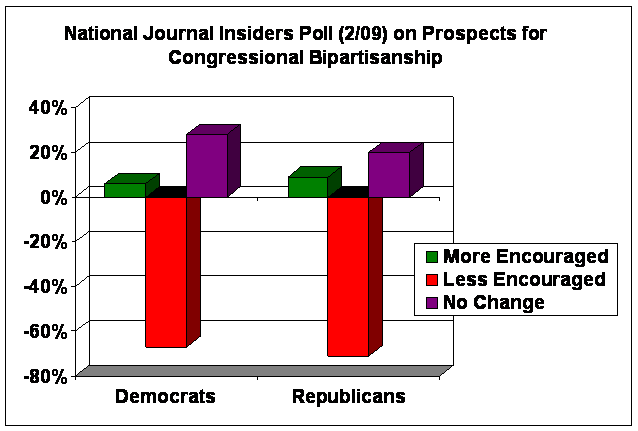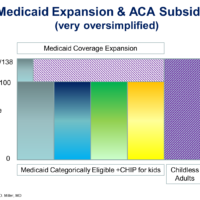The prospect for Federal health reform legislation remains high because of the growing need, Democratic control of Congress, and a lower barrier to major actions because of the economic situation. However, opposing these positive factors are the apparent unraveling of broad coalitions supporting fundamental health reform, and lower expectations for bipartisanship in Congress.
Growing conflicts within health reform coalitions was reported in Tuesday’s Chicago Tribune, (and discussed on the HealthBeatBlog), but this dis-cohesion was very predictable when it came time to talk specifics. Unfortunately, the prospects for bipartisan action on health reform also seem to have faded sooner than one would have hoped. This was seen in the recent National Journal’s Insider’s Poll which asked the question –
“Have events of recent weeks made you more encouraged or less encouraged about prospects for bipartisanship this year on major issues that Congress has yet to tackle, such as health care reform and energy legislation?” [emphasis added]
The responses to this question from 36 Democratic and 35 Republican Insiders was:
The fight over the stimulus legislation clearly has driven a hammer down on bipartisanship in Congress. This will make passing health reform legislation harder, since health reform is never easy and the one bipartisan example of major health legislation in recent decades was HIPAA. The development and passage of HIPPA demonstrate the value of bipartisan leadership for moving a substantive and complex piece of legislation through the process. (For HIPAA, that bipartisan leadership came from Senators Kennedy and Kassebaum – who retired in 1997 after the law’s passage.)
Conversely, examples go back months, years and decades, showing that narrow, partisan voting has been the norm in health legislation. For example, the recent SCHIP reauthorizations were subject to multiple rounds of partisan wrangling, the Medicare Modernization Act in 2003 passed by 1 vote, with 9 Democrats voting in favor and 19 Republicans voting against, and the 1993-94 health reform initiative dissolved, in part, because of lack of leadership and partisan maneuvering.
Agreeing on a Second Choice
While faltering coalitions and partisanship certainly present real hurdles, the overarching challenge for overcoming these barriers will be to see if Stuart Altman’s well known insight about health reform can be turned on its head. That is, while it is unlikely that there will ever be broad consensus about the structure for health reform, Professor Altman has observed that everyone’s second choice has been the status quo. However, if everyone’s second choice can be flipped to “anything but what we have now,” then with adequate leadership and a reasonable plan, significant reform may be possible.
Economy as a Catalyst?
The economic situation may be the catalyst to drive people to support “anything but what we have now.” But agreement on that second choice option won’t itself determine the substance for health reform legislation. To actually pass a law and implement the reforms it contains, the proposal must be explainable as to how it will both work and benefit individuals, society, and the economy. This will clearly take leadership – and likely some level of bipartisan agreement in Congress. While the prospects for bipartisanship seem bleak now, if it changes, and a health reform proposal is developed that is practical, defensible, and addresses the cost, access and quality concerns that are worrying patients, families and businesses, then real health reform is possible.


